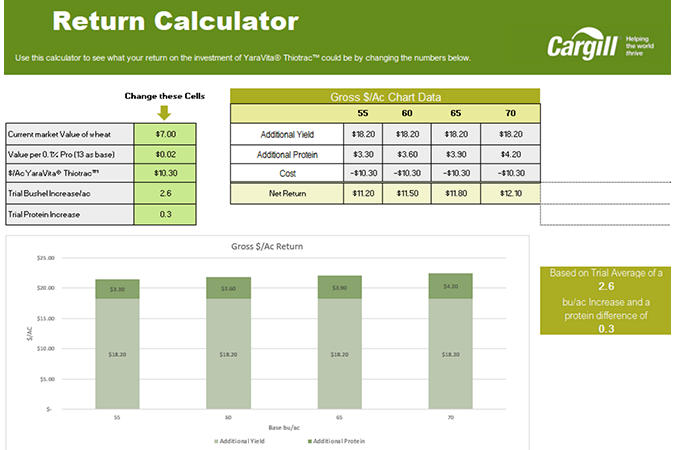When to build protein in wheat based on the market
Let grain marketing expertise be your guide to foliar nutrition decisions
For farmers who like to get strategic with their grain marketing plan and have options for separating and storing grain on-farm, there’s a way to increase net return on wheat by up to $11.80/acre.
That strategy is growing, contracting – and sometimes blending – your wheat to create the grade that is commanding the highest price on the market in the month you want to sell. The key is tracking US wheat protein results and market value early in the season.
The value of high protein wheat is set in June
The Canadian market doesn’t set the value of protein on its own – the US market does. When American farmers harvest their winter wheat in June, it starts setting the market value for protein for the year. That’s convenient timing for Canadian farmers. You can look at the market and your wheat crop and decide if you want to add foliar nutrition to the tank with your fungicide application to target a higher protein level.
The protein market is volatile
The value of different protein levels changes drastically year to year, depending on weather and protein supply from the US wheat crop. There are markets for both high and low: 14-15% protein wheat is used for traditional Western high-rise bread, and 12-13% protein is used for flatbreads, snack and cereal products.
Cargill needs both high- and low-protein wheat to meet the needs of end-use customers. Typically, the higher the protein level, the higher the price the end user has to pay. But they will only buy the pre-set amount of high protein wheat they need for their final blend. As a result, if there’s a bumper crop of higher protein wheat (e.g. 12.5% red winter wheat), the end-use customer will pay a much smaller premium; and as a result, there is less incentive for farmers to produce high protein wheat.
Marketing protein requires two experts
As a farmer, you can’t know your wheat protein until the crop is harvested. But the window to target higher protein with a foliar nutrition application is in June. So how do you decide whether to invest in another input when the future value of that crop is unknown?
Here’s our recommendation: In early June, invite your agronomist and grain marketing advisor to look at your wheat fields. Your advisor can tell you what’s happening with the US market and what kind of price is attainable for high- and low-protein wheat.
Suppose the market is looking favourable for high-protein wheat. Your agronomist will assess the fertility of the field and recommend a foliar product with the right blend of nutrients for the crop. Bear in mind that applying foliar nutrition doesn’t guarantee a protein bump. Our on-farm Field Tests of YaraVita® Last N™ 25-0-0 and YaraVita Thiotrac™ 300 (15-0-0 + 22.8%S) have shown some promising results, but environmental conditions will heavily influence a wheat crop’s final protein content.

Next, you and your grain marketing advisor will fill out our ROI calculator to determine the margin you can expect to make on different wheat protein levels. At that point, you can decide if a foliar product is worth the investment.
As a form of insurance, we often advise growers to forward contract a portion of their wheat production to lock in a price and base grade. If you’re not sold, you’re subject to the variability of the market.
Best practices for sampling and storing wheat
If you’re applying foliar nutrition for the first time, take it to trial on your farm. Leave a test strip in the field so you can compare results.
When you harvest the field, sample every truckload of grain if possible. Store the high-protein wheat separately from the lower protein wheat on your farm. Then, meet with your grain marketing advisor to assess the protein market. Your advisor will track protein premiums and advise you on delivery periods that are advantageous for the lower protein wheat (e.g. 13%) and ones that are better for the higher protein wheat (e.g. 14.5%). This is how Cargill has been able to help MarketSense customers increase their wheat ROI by $11.80/acre.
If you’re interested in protein marketing strategies, start talking to your agronomist and grain marketing advisor now. You can look at past wheat crops and soil fertility to set a benchmark for wheat protein on your farm, then you can develop a plan to target higher protein and ROI next growing season.
YaraVita is a registered trademark and Thiotrac is a trademark of Yara Canada and Yara International ASA
